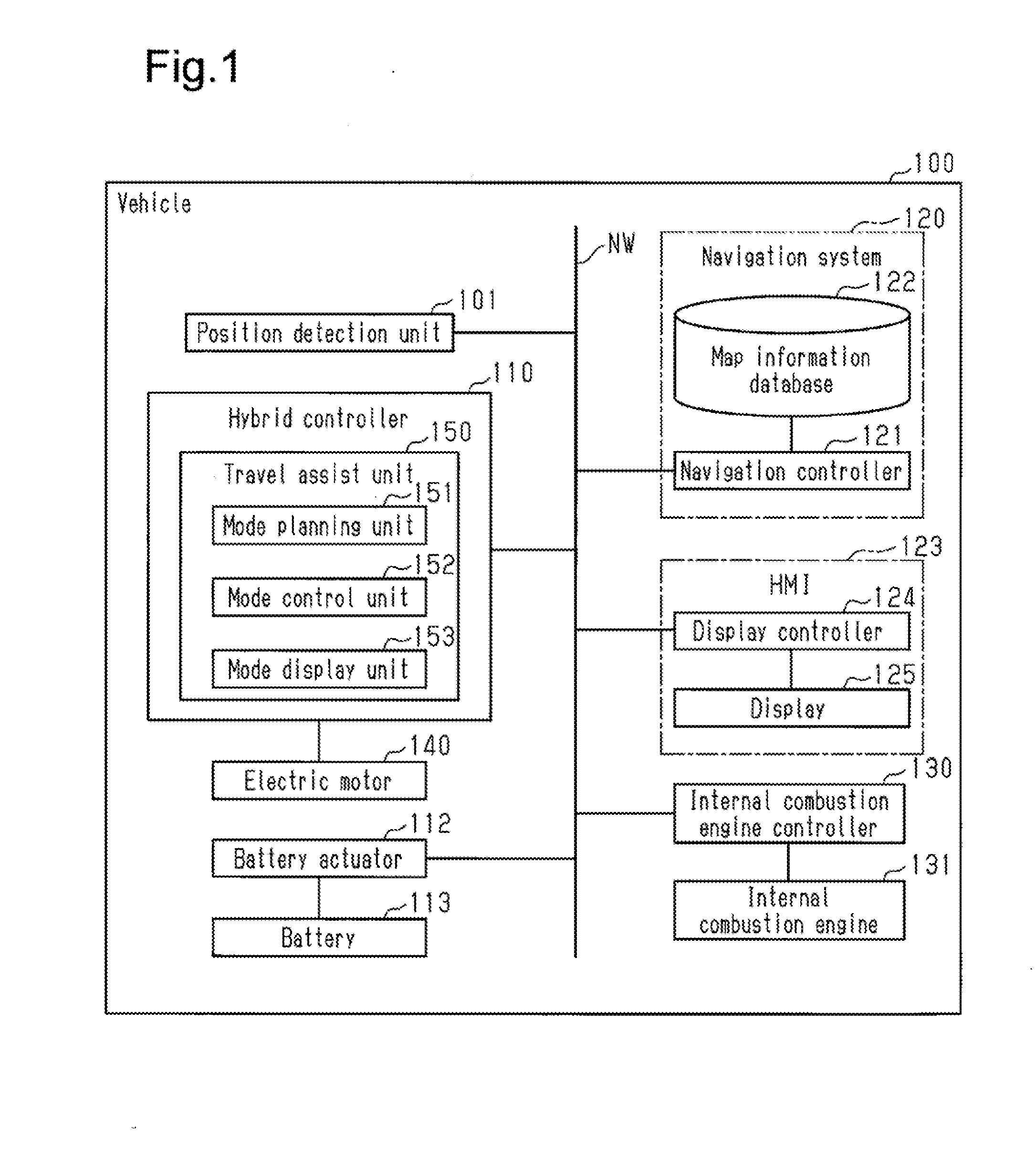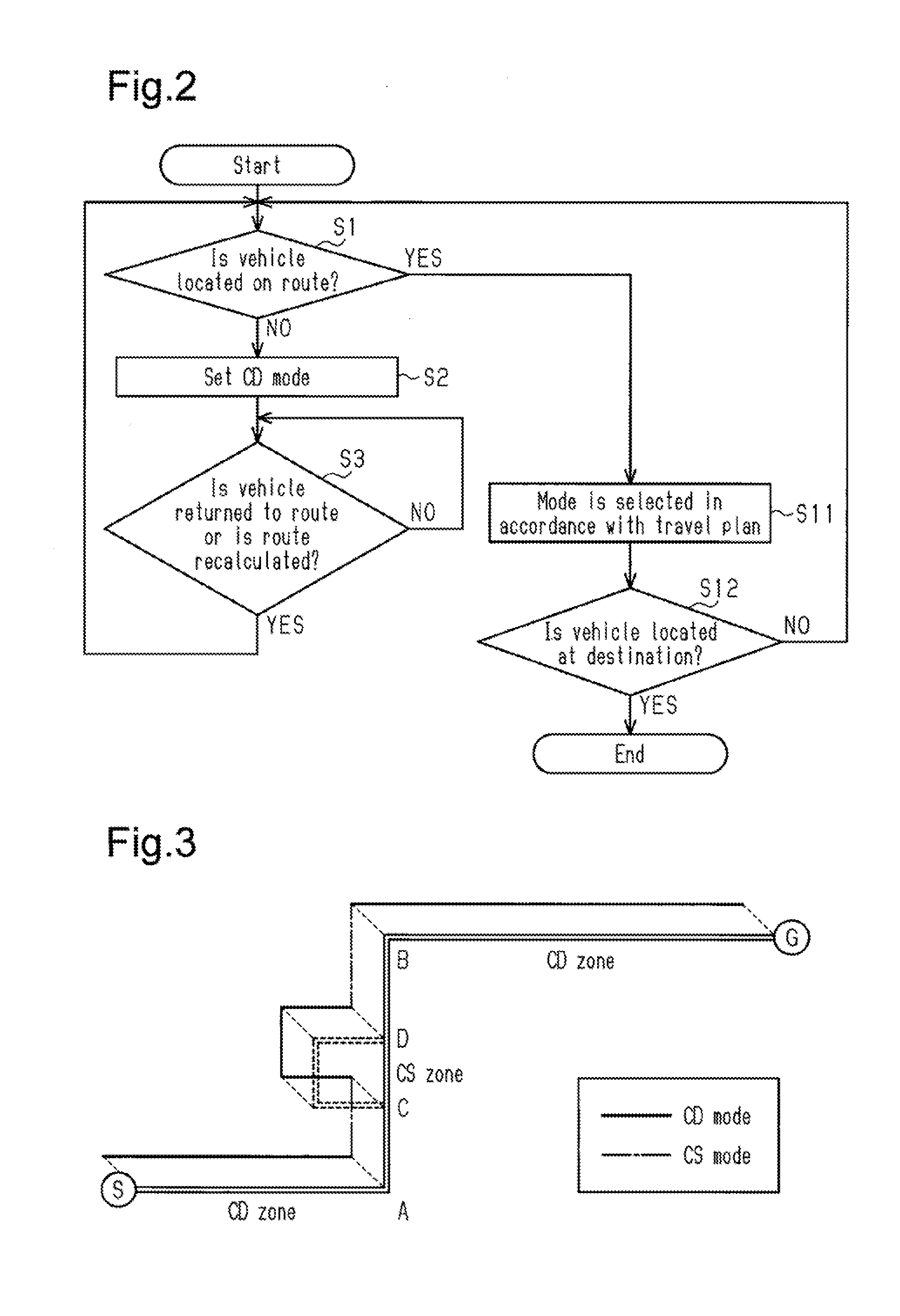Vehicle controller
- Summary
- Abstract
- Description
- Claims
- Application Information
AI Technical Summary
Benefits of technology
Problems solved by technology
Method used
Image
Examples
first embodiment
[0045]A first embodiment of a vehicle controller will now be described with reference to FIGS. 1 to 3. The vehicle controller of the first embodiment is a device that is installed in a vehicle 100, which uses an internal combustion engine 131 and an electric motor 140 as drive sources, and controls a travel mode of the vehicle 100. The vehicle 100 is, for example, a plug-in hybrid vehicle.
[0046]The structure of the vehicle controller of the first embodiment will now be described.
[0047]The vehicle 100 travels in two modes. One mode is a charge depleting (CD) mode, which consumes power of a battery 113 and serves as a first mode. Another mode is a charge sustaining (CS) mode, which sustains the amount of power stored in the battery 113 and serves as a second mode. For example, the CD mode gives priority to EV traveling, in which the vehicle 100 drives only the electric motor 140 and stops the internal combustion engine 131 when traveling. Thus, power of the battery 113 is consumed. Th...
second embodiment
[0083]A second embodiment of the vehicle controller will now be described with reference to FIGS. 6 to 9.
[0084]The vehicle controller of the second embodiment differs from that of the first embodiment in that when the vehicle 100 deviates from the planned route and then the vehicle returns to the route or the route is recalculated, the travel mode of the vehicle 100 is maintained in the CD mode for a predetermined time. The description will focus on the differences from the first embodiment.
[0085]As shown in FIG. 6, the mode control unit 152 of the second embodiment performs the process that is the same as steps S1 to S3 of the first embodiment. Then, the mode control unit 152 calculates a time elapsed from when determining that the vehicle 100 returns to the planned route or the navigation system 120 recalculates the route (step S4).
[0086]Here, the vehicle 100 may deviate from the planned route, return to the zone to which the CS mode is assigned (CS zone), and again deviate from t...
third embodiment
[0097]A third embodiment of the vehicle controller will now be described with reference to FIGS. 10 to 12. The vehicle controller of the third embodiment differs from that of the first embodiment in that when the vehicle 100 deviates from the planned route and then the vehicle returns to the route or the route is recalculated, the travel mode of the vehicle 100 in the first zone is maintained in the CD mode. The description will focus on the differences from the first embodiment.
[0098]As shown in FIG. 10, the mode control unit 152 of the third embodiment performs the process that is the same as steps S1 to S3 of the first embodiment. After determining that the vehicle 100 returns to the planned route or the navigation system 120 recalculates the route, the mode control unit 152 sets the CD mode in the first zone subsequent to the return or recalculation (step S6).
[0099]Here, the vehicle 100 may deviate from the route when traveling a CS zone and then return to the CS zone. In such a...
PUM
 Login to View More
Login to View More Abstract
Description
Claims
Application Information
 Login to View More
Login to View More - R&D
- Intellectual Property
- Life Sciences
- Materials
- Tech Scout
- Unparalleled Data Quality
- Higher Quality Content
- 60% Fewer Hallucinations
Browse by: Latest US Patents, China's latest patents, Technical Efficacy Thesaurus, Application Domain, Technology Topic, Popular Technical Reports.
© 2025 PatSnap. All rights reserved.Legal|Privacy policy|Modern Slavery Act Transparency Statement|Sitemap|About US| Contact US: help@patsnap.com



